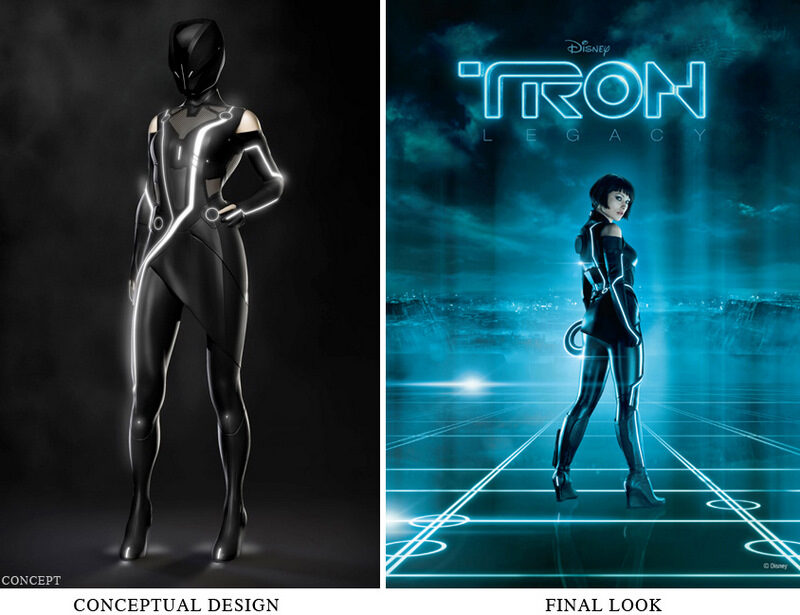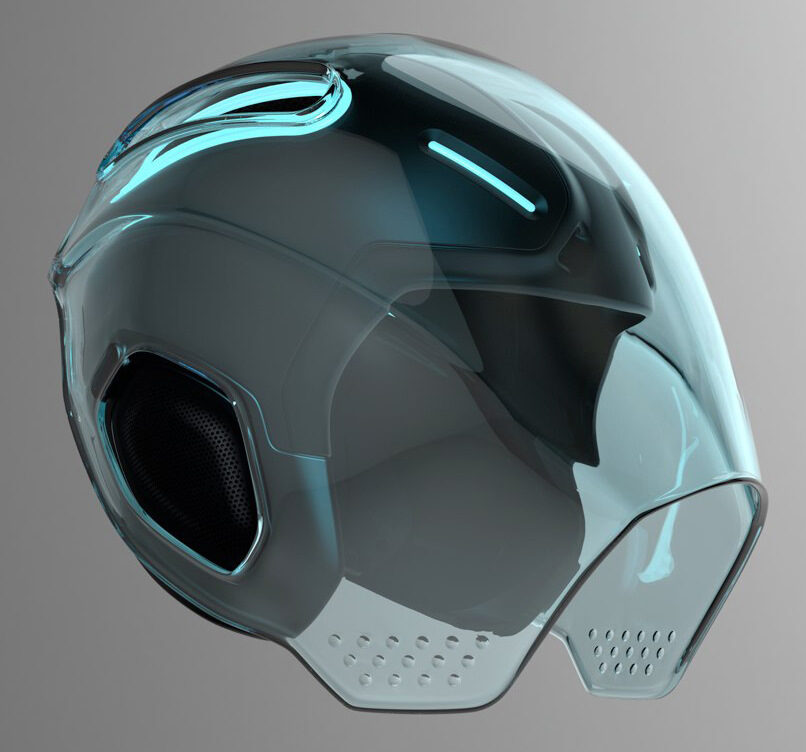Tron Legacy: Light Suit Costume |
 © 2010, Disney 9 Nov ’10
© 2010, Disney 9 Nov ’10
In Tron Legacy, the light suit exemplifies two key facets of the mythology: light, as in energy, and ‘disc’ – lifeblood of the wearer. This suit is a meticulously designed ‘second skin’ that integrates seamlessly into director Joseph Kosinski’s vision of the Tron story universe. Here we examine the design of the new light suit including background to its creation, construction, symbolism and application in Tron Legacy.
‘The Grid’ is such a heavily computer generated world that the light suit was considered a practical means of bringing this environment to life for actors. Moreover, to physically illuminate each suit in post-production would have been too expensive. Costume designers Michael Wilkinson, Christine Bieselin Clark and Neville Page (helmets) really wanted to recapture a sense of awe from the original film – the ‘how did they do that?’, as Christine terms it.
The light suit is made from Spandex (elastane) covered by a hexagonal pattern and interspersed with latex-foam. Sometimes it is a one-piece, sometimes more, depending on the character design. Despite a gleaming appearance there is no leather on any of these costumes; all are covered in an industrial ‘buffing’ gloss instead. Light is passed through the suit via Light Tape® (produced by Electro-LuminX of Chester, VA) attached to connectors and wired to a PP3 9V battery pack hidden in the disc and then attached to the rear of the costume by magnets.
Mike Hardcastle from Light Tape UK, who are currently working with Disney for the UK premiere of Tron Legacy, explains the application of Light Tape® in the film:
To achieve the consistency, quality and brightness Light Tape® is made using GTP (Sylvania) phosphors and Honeywell lamination. The main colour used for the movie was the Natural Blue, though they also used Extreme Orange, International Red and Yellow. These colours are made by overlaying a transparent 3M Vinyl film over the phosphor before lamination.
Building the light suit itself was an expectedly complex process. Notes Christine Clark:
We wanted a perfection, and symmetry, and beauty to the costume, while also incorporating this practical lighting element that had never been done before on this scale.
The majority of the suits were designed in 3D using digital moulding program ZBrush. After downloading an actor’s body scan into a computer, the suits’ original 2D illustrations were overlaid to provide an output manufacturing tool. This was the first step in deciding where the actual lighting elements would be situated.
Taking Garrett Hedlund’s (playing Sam Flynn) process as an example (below), a scan was taken of his entire body then the suit illustration superimposed in order to figure out the costume fabric, where foam could be inserted, etc. Using a CNC (Computer Numerical Cutting) of high-density foam, an initial small scale output would be made so any fine details were perfected before construction of the full size light suit.
The CNC process tends to cause bubbles and striation in the output. As such, lines needed to be refined and a hard coating applied from which to take the final mould. During this process the lighting channels had to be incorporated along with wiring harnesses, which were eventually embedded directly into the foam (causing further striation to be corrected). Christine concludes the process:
The (light) suit is all made of a hexagon mesh which we also printed and made the fabric from 3D files. This would go onto the hard form; it would go inside the mould which was silicon matrix. We would put those together and then inject foam into the negative space. The wiring harness is embedded into the mould and you get a torso. We then paint it and that’s your finished suit.
Around 150 suits were created for different characters in the film. Unusually the costume team was also responsible for their accompanying helmets. Normally these are sourced or made by the prop department, but central to having the suit aligned with the Grid was its absolute symmetry head to toe.
These helmets were incredibly intricate in plan and assembly. They all feature independent power units for illumination, again Light Tape®, ideal for use on rigid pieces, e.g. hard hats. Lead designer for all helmets Neville Page explains his intentions:
The art departments communicated very well with each other to realise Joe’s (Kosinski) vision. We would look over each other’s shoulders to find inspiration from one another. he development of the costumes came from trying to develop the form language which came from within the film.
We will now move onto more specific design elements created for individual characters. N.B. Some fabric and helmets have been viewed close up, while most information was gleaned from first hand interviews/discussions with Christine Clark and Neville Page.
Jeff Bridges as Kevin Flynn/CLU 2.0
Kevin Flynn was a video game designer who in 1982 created a fantastic digital world called the Grid. After becoming trapped inside the Grid and ultimately escaping back to reality, in 1984 he made a program CLU 2.0 and secretly used his creation to construct a micro utopia. However in 1989 he suddenly disappeared leaving his young son behind. No-one has heard from him since. Not until now.
Being as Kevin is something of a hippie character within the Grid, his costume is organic looking and free flowing. His white polyester cloak in particular has many light panels incorporated to suggest an aura from within.
His alter-ego (or son?) CLU is polar opposite. Though Jeff Bridges was on set to read lines, a stand-in for the actor wore a light suit for blocking, due to the fact that Bridges is no longer physically the young man his computer generated face was intended to project. His build is different, he moves differently; obviously like a 61 year old. The CLU helmet design was Page’s toughest challenge:
The actor cannot see a thing through the helmet. He is wearing heads up display goggles, and there is a little camera in that pyramid shape that is seeing for him.
Considering all the power and technology located inside, the helmet was cooled by internal fans. CLU and all programs loyal to him in the Grid wear suits and drive vehicles emblazoned with orange, red and yellow; conversely Grid dwellers wear only white, blue and silver.
Our analysis of individual character costumes for Tron Legacy continues HERE in Part 2.
© 2010 – 2013, Chris Laverty.







